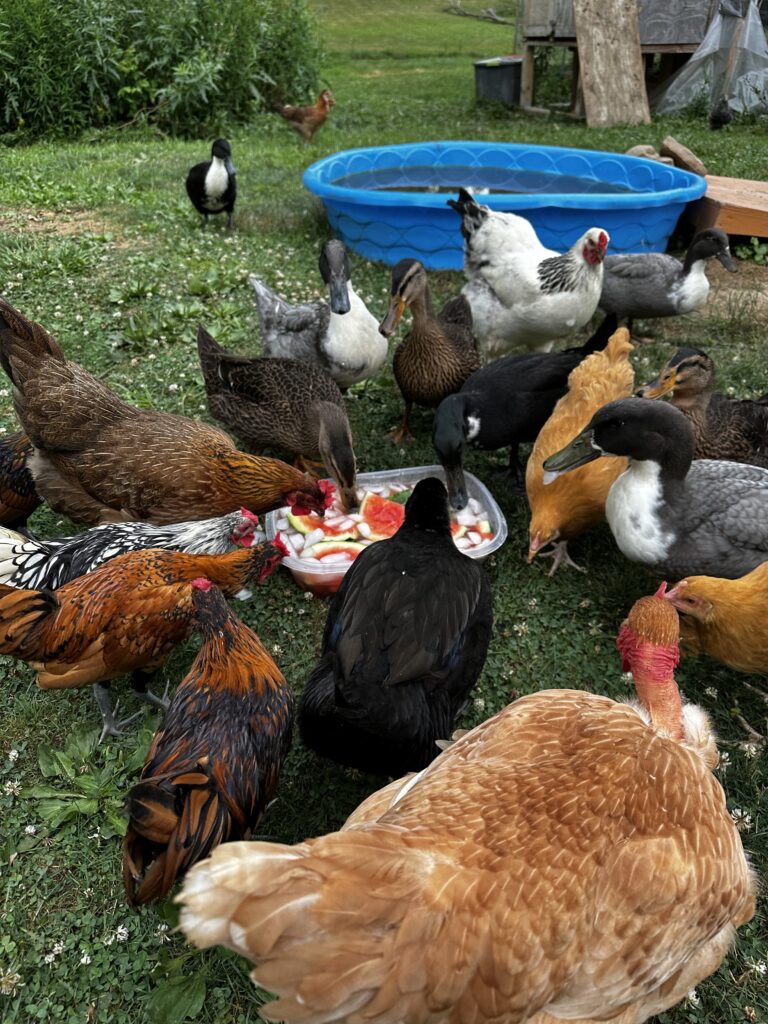How to Keep Chickens Cool in Summer Heat
Hot weather can be hard on chickens. Unlike humans, chickens can’t sweat, so they rely on panting and spreading their wings to try to release excess heat. In extreme temperatures, they’re at risk for heat stress or even death.
Thankfully, there are plenty of ways you can help your flock stay cool and comfortable when the thermometer climbs. Here are my simple, effective strategies to beat the heat.
🧊 1. Provide Cold Treats
Nothing perks up an overheated hen like a chilly snack. Here are some favorites:
- Frozen Fruits:
Freeze berries, watermelon chunks, grapes, or a bag of frozen fruit from the store. Drop them into a bowl of cold water or and place it in the run. Chickens love pecking at them as they thaw, and will be forced to drink some cold water in the process. - Ice Blocks with Fruit:
This one is a party pleaser! Fill a plastic or silicon container with water, toss in chopped fruits or veggies, and freeze overnight. Pop the ice block into the run when it starts getting hot—your chickens will stay busy and cool as it melts. - Frozen Veggie Mix:
Bagged peas or mixed vegetables can be frozen and sprinkled around for a refreshing treat. I like scattering frozen greens around the yard so they can forage for them.
💦 2. Keep Fresh, Cool Water Available
Water is your number one defense against heat stress. Make sure:
- Waterers are kept clean and in the shade, and refilled often.
- You add a few ice cubes to waterers during the hottest part of the day. In extreme heat, freeze a small Tupperware container full of water overnight. In the morning, place the chunk of ice in their waterer. The larger volume will prevent it from melting longer!
- You have multiple water stations so everyone has access. Scatter them around their available area so they have easy access no matter where they are.
- Consider using larger containers—water stays cooler longer in bulk. A 55 gallon drum have a hard time getting as hot as a small waterer.
🧱 3. Use Cool Surfaces to Lower Body Temperature
Chickens release body heat from their comb, wattles, and feet and will often look for something cool to stand or lay on. Try:
- Red Clay Bricks in Cold Water:
This one works specifically with red clay bricks as they will absorb the cold water and hold it much longer than the ice lasts. Take a shallow pan, put a few of the bricks in there, and fill with ice and water and place in the shade. Chickens will stand on them to draw heat away from their bodies, almost acting as an outdoor A/C unit. - Ceramic Tiles:
Place them in the freezer overnight and set them out during peak heat hours. Ceramic holds the cold temperatures for a long period and are easy to stack in your freezer. Just be sure none are chipped and have sharp edges!
🕶️ 4. Provide Ample Shade
Even with all the cold treats, shade is essential:
- Erect a simple tarp, shade cloth, or old sheet over part of the run. Just grab a few staples and some bricks to weigh it down, and you’re good to go.
- Use garden umbrellas or pop-up canopies.
- Move portable coops under trees.
- Consider planting fast-growing shrubs or vines along fences for natural shade. They love to disappear into the brush and plants on hot days to cool down and dust bathe.
💨 5. Improve Ventilation in the Coop
If your chickens are confined during the day, airflow is critical:
- Open windows or vents—secure them with hardware cloth.
- Install fans (safe and designed for outdoor use) to move hot air out. Solar powered fans are available online and do a great job at keeping air moving.
- Avoid overcrowding—more birds = more body heat.
Tip: Never lock chickens in a hot coop during the day unless absolutely necessary.
🌬️ 6. Offer a Dust Bath Area
A dry, shady dust bath lets chickens cool off and control parasites. Keep it:
- In the shade.
- Loose and dry—add clean sand or wood ash for a better dust bath.
Some chickens will dig deeper pits to find cooler soil. In my experience they prefer to dig their own dust baths over the ones I make for them.
💧 7. Mist the Run or Use Sprinklers
Lightly spraying the ground reduces ambient temperature, but can increase humidity and promote mold if not properly drained:
- Mist the run floor in the morning and again mid-afternoon.
- Use a hose with a gentle sprayer.
- Avoid directly spraying chickens—they usually hate it, though some will walk through if they’re really hot.
🍉 8. Feed During Cooler Hours
- Offer feed early in the morning and again in the evening. Chickens are less active during peak heat and will likely not want to eat in the first place.
- Chickens naturally eat less when it’s hot, so don’t be alarmed. More carbohydrates in their body means hotter body temperatures, so they will naturally eat less to stay cool.
- Cold treats during the day can help keep them hydrated.
🛑 Watch for Signs of Heat Stress
Even with all these measures, monitor your flock closely. Signs of heat stress include:
- Rapid panting
- Wings held away from the body
- Lethargy or confusion
- Pale combs and wattles
- Droopy posture
If you see these signs, act immediately:
- Move chickens to a cooler area.
- Offer cold water.
- Place feet in cool (not ice-cold) water if needed.
The goal is to cool off their internal body temperature quickly, before heat stroke sets in. If a dunk in cold water is necessary, it is as a last resort to not lose your chicken. Providing the chickens ample opportunity to cool off will always be the best way to prevent injury or death.
🐔 Final Thoughts
Keeping chickens cool in the summer doesn’t have to be complicated. A combination of shade, ventilation, fresh water, and cold treats will go a long way toward keeping your flock healthy and comfortable.
Stay vigilant during heat waves, and your chickens will thank you with continued laying and lively behavior, even when it’s sizzling outside.

Discover more from Cluck N' Quack Chronicles
Subscribe to get the latest posts sent to your email.
